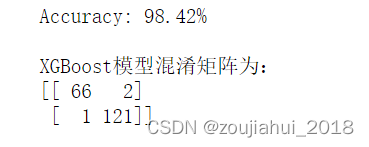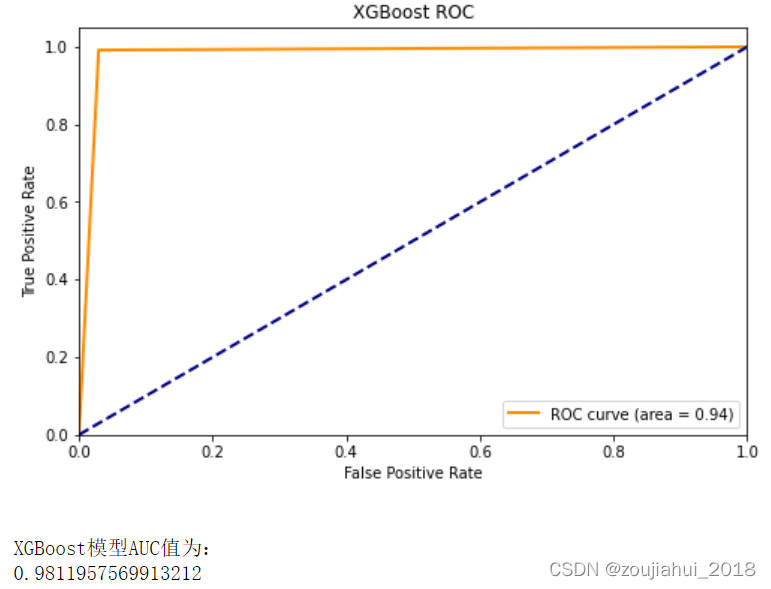- 1C# message简单实现窗口间信息接收与发送_c# wm_user 消息为空
- 2【数据结构】数据结构初识
- 3微信小程序授权登录三种实现方式
- 4微信小程序入门05-用户登录注册接口开发_微信小程序实现注册登录到数据库
- 5Python pywinauto+lackey实现自动安装软件_lackey python
- 6Docker容器的可视化管理工具—DockerUI本地部署与远程访问
- 7[翻译] Unity 开发自学路线_unity 学习路线
- 8关于“Python”的核心知识点整理大全45
- 9使用cdn提高Github Pages的访问速度_github cdn
- 10解决Microsoft Visual C++ 14.0 or greater is required. Get it with “Microsoft C++ Build Tools“_error: microsoft visual c++ 14.0 or greater is req
XGBoost模型的python实现_python实现xgboost模型
赞
踩
作者:李雪茸
函数介绍
实现 XGBoost 分类算法使用的是 xgboost 库的 XGBClassifier,具体参数如下:
-
1、max_depth:给定树的深度,默认为3
-
2、learning_rate:每一步迭代的步长,很重要。太大了运行准确率不高,太小了运行速度慢。我们一般使用比默认值小一点,0.1左右就好
-
3、n_estimators:这是生成的最大树的数目,默认为100
-
4、objective:给定损失函数,常用的有:
– reg:linear– 线性回归
– reg:logistic – 逻辑回归
– binary:logistic – 二分类逻辑回归
– binary:logitraw – 二分类逻辑回归
– count:poisson – 计数问题的poisson回归 -
5、booster:给定模型的求解方式,默认为:gbtree;可选参数:gbtree、gblinear,gbtree是采用树的结构来运行数据,而gblinear是基于线性模型
-
6、gamma:指定了节点分裂所需的最小损失函数下降值。这个参数的值越大,算法越保守。范围: [0,∞]
-
7、alpha:L1正则项的权重,推荐的候选值为:[0, 0.01~0.1, 1]
-
8、lambda:L2正则项的权重,推荐的候选值为:[0, 0.1, 0.5, 1]
-
9、num_class:用于设置多分类问题的类别个数
-
10、min_child_weight:指定子节点中最小的样本权重和,如果一个叶子节点的样本权重和小于min_child_weight则拆分过程结束,默认值为1。
-
11、subsample:默认值1,指定采样出 subsample * n_samples 个样本用于训练弱学习器。取值在(0, 1)之间,设置为1表示使用所有数据训练弱学习器。
-
12、colsample_bytree:构建弱学习器时,对特征随机采样的比例,默认值为1
实例
from xgboost import XGBClassifier
from sklearn.datasets import load_iris
from sklearn.datasets import load_breast_cancer
from sklearn import metrics
from sklearn.metrics import accuracy_score
from sklearn.model_selection import train_test_split
from sklearn.metrics import roc_curve, auc
import matplotlib.pyplot as plt
- 1
- 2
- 3
- 4
- 5
- 6
- 7
- 8
二分类问题
# 举例(二分类) cancer = load_breast_cancer() x = cancer.data y = cancer.target x_train, x_test, y_train, y_test = train_test_split(x, y, test_size=0.333, random_state=0) # 分训练集和验证集 model = XGBClassifier(max_depth=10, learning_rate=0.01, n_estimators=2000, objective='binary:logistic', nthread=-1, gamma=0, min_child_weight=1, max_delta_step=0, subsample=0.85, colsample_bytree=0.7, colsample_bylevel=1, reg_alpha=0, reg_lambda=1, scale_pos_weight=1, seed=1440) model.fit(x_train, y_train,eval_metric='auc')# 'rmse’:用于回归任务 ;'mlogloss’,用于多分类任务; # 'error’,用于二分类任务; 'auc’,用于二分类任务 # 对测试集进行预测 y_pred = model.predict(x_test) predictions = [round(value) for value in y_pred] #计算准确率 accuracy = accuracy_score(y_test, predictions) print("Accuracy: %.2f%%" % (accuracy * 100.0)) print(f"\nXGBoost模型混淆矩阵为:\n{metrics.confusion_matrix(y_test,y_pred)}") ####绘制ROC曲线 fpr1,tpr1,threshold1 = roc_curve(y_test,y_pred) roc_auc1 = auc(fpr1, tpr1) lw = 2 plt.figure(figsize=(8, 5)) plt.plot(fpr1, tpr1, color='darkorange', lw=lw, label='ROC curve (area = %0.2f)' % roc_auc) plt.plot([0, 1], [0, 1], color='navy', lw=lw, linestyle='--') plt.xlim([0.0, 1.0]) plt.ylim([0.0, 1.05]) plt.xlabel('False Positive Rate') plt.ylabel('True Positive Rate') plt.title('XGBoost ROC') plt.legend(loc="lower right") plt.show() print(f"\nXGBoost模型AUC值为:\n{roc_auc_score(y_test,y_pred)}")
- 1
- 2
- 3
- 4
- 5
- 6
- 7
- 8
- 9
- 10
- 11
- 12
- 13
- 14
- 15
- 16
- 17
- 18
- 19
- 20
- 21
- 22
- 23
- 24
- 25
- 26
- 27
- 28
- 29
- 30
- 31
- 32
- 33
- 34
- 35
- 36
- 37
- 38
- 39
- 40
- 41
- 42
- 43
- 44
- 45
- 46


多分类问题
###举例 (多分类) # 加载样本数据集 iris = load_iris() X,y = iris.data,iris.target X_train,X_test,y_train,y_test = train_test_split(X,y,test_size=0.2,random_state=12343) model = XGBClassifier( max_depth=3, learning_rate=0.1, n_estimators=100, # 使用多少个弱分类器 num_class=3, booster='gbtree', gamma=0, min_child_weight=1, max_delta_step=0, subsample=1, colsample_bytree=1, reg_alpha=0, reg_lambda=1, seed=0 # 随机数种子 ) model.fit(X_train,y_train,eval_metric='mlogloss')# 'rmse’:用于回归任务 ;'mlogloss’,用于多分类任务; # 'error’,用于二分类任务; 'auc’,用于二分类任务 # 对测试集进行预测 y_pred = model.predict(X_test) predictions = [round(value) for value in y_pred] #计算准确率 accuracy = accuracy_score(y_test, predictions) print("Accuracy: %.2f%%" % (accuracy * 100.0)) print(f"\nXGBoost模型混淆矩阵为:\n{metrics.confusion_matrix(y_test,y_pred)}")
- 1
- 2
- 3
- 4
- 5
- 6
- 7
- 8
- 9
- 10
- 11
- 12
- 13
- 14
- 15
- 16
- 17
- 18
- 19
- 20
- 21
- 22
- 23
- 24
- 25
- 26
- 27
- 28
- 29
- 30
- 31




